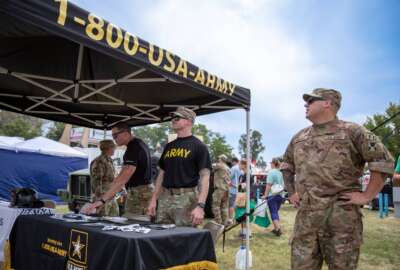The Army has a problem with water-borne transportation
The demand for watercraft is rising, but the Army's fleet is shrinking. The GAO has a few recommendations for what's becoming a critical problem.
You might not think of the Army as having a big need for watercraft. But it does. Like when it has to move tanks from point A to point B. In fact, the demand for watercraft is rising, but the Army’s fleet is shrinking. The Government Accountability Office has a few recommendations for what’s becoming a critical problem. GAO’s director of defense capabilities and management issues, Diana Maurer, joined the Federal Drive with Tom Temin to provide more details.
Read the GAO report here: https://www.gao.gov/products/gao-25-106387
Interview transcript:
Tom Temin: So the Army has a Navy, you might say?
Diana Maurer: The Army has a Navy. I don’t know that surprises a lot of people. But for many, many years, the Army has had a number of what they call vessels. They’re very careful not to call them ships. They’re vessels to move materiel and equipment around the globe where it’s needed. If you go back in history, there were times when they had several thousands of these. The size of their fleet has shrunk. They now have currently about 70 of these watercraft that are designed to move equipment and materiel and effectively to move them in, really what the Army calls austere environments. So not necessarily where there is a port. These things can sail across the ocean. They can sail in shallow waters, in some cases, right up to the beach and deliver equipment where it’s needed.
Tom Temin: Yeah, I was going to say, they can cross the ocean, but they look from the pictures about the size of fishing boats in length.
Diana Maurer: Yeah, they come in varying sizes but they can cross the ocean now. The caveat there is these are flat-bottomed boats. So they move across the ocean very slowly. And you’ve got to be very careful because they’re not necessarily as seaworthy as sort of a naval vessel. But it is possible to do that.
Tom Temin: Right. So these would then be used to, say, augment what the Sealift Command and so forth is able to do for the Army itself?
Diana Maurer: Exactly. In many respects, they’re designed to provide that last tactical mile between much larger ships with a whole bunch of stuff. They put them on these smaller army watercraft and get to the last mile where they can deliver it to either a small port or ashore where it’s needed. I think as many people might know, the Army used watercraft as part of the humanitarian mission in Gaza over the course of the last several months.
Tom Temin: So what’s going on with them? The fleet is shrinking, but the demand is rising. You have written. What’s going on?
Diana Maurer: So back in 2018, the Army was taking a hard look at its budget and its priorities. And the Army leadership at that time decided it’s time to say goodbye to the entire fleet of Army watercraft. They wanted to get rid of everything that they had in its inventory at that time, which is roughly about 140 or so vessels. Those vessels were old. They were poorly maintained and it cost the Army resources to keep them up and running. Congress stepped in and the long story short, as the Army shed about half of the size of its fleet, they currently have 70. However, since then, there’s been an increase in demand for that fleet. So, for example, in Gaza, there’s also very a great deal of demand for Army watercraft in the INDOPACOM region on the Pacific Ocean to meet a lot of the Army missions. One of the key findings in our report is that there is now a tremendous gap between the size of the fleet that the Army has and the demands that are coming out of just INDOPACOM. And closing that gap is a major challenge for the Army.
Tom Temin: I guess the question, the obvious question seems to be what were they thinking back in 2018? If they’ve been using these things for a century or ever since tanks or whatever the case might be, why they would not need any of them anymore?
Diana Maurer: I think at that time, they were putting their eggs in the basket of developing new systems. And also there was a different concept of operations that I think they had in mind back then. Since then, obviously we’ve had two national defense strategies that have come out that have placed increased emphasis on China. The Army’s developing different units that are more focused on the Pacific than they were. So there are a number of things have changed in the strategic environment that have increased both the importance of army watercraft as well as the demand for their use.
Tom Temin: So I imagine in whatever scenarios they’re working on, these would be needed, say, in and around Taiwan?
Diana Maurer: Potentially, right. The Army, if it’s going to be moving some of its units between different islands, they need to move the material and they can rely on their watercraft fleet to do that. Now, of course, one of the main problems that we found is that Army’s watercraft are in very poor condition. The Army’s goal is that 90% of its fleet should be fully mission capable, which means ready to go and operate in as desired. We found that in 2024, the Army’s actual rate was about 35%. So that’s a tremendous gap. That’s a significant problem. And it’s grounded in the fact that these are very old, very poorly maintained, and there are big gaps between what the Army wants and what they’re capable of doing.
Tom Temin: Yeah. Grounded is a good word. We’re speaking with Diana Maurer, director of defense capabilities and management issues at the GAO. So about 25 of the 70 are actually operational and now they need even more than the 70. So what do you recommending? They don’t have time to develop new and acquire new ones any time soon.
Diana Maurer: Right. Exactly. So the Army is in the process of thinking about building new systems. But those are still several years off. So we had a recommendation, a couple of recommendations to the Army. One was you need a bridging strategy, right. If your strategy was build new watercraft, maybe that’s great. But those are going to be many years down the road. So you need to think about what are you going to do in the interim? Are there things that you can do? Can you rely on craft that are available in the private sector? Can you work with others to bring other craft online? They used to have a reserve component. Do you want to resurrect those? There are a number of different options that the Army could consider. And related to that, weigh a second recommendation of the Army take a hard look at the costs and benefits of trying to close this gap or trying to rather to bridge that gap between what they currently have and what they’re planning to build in the future. Both those recommendations are critical to getting the Army to where they want to be. And the Army agreed to take actions to address both.
Tom Temin: And you reference a group called the Army Watercraft Governance Board. Is that something that has arisen because of this need or has that been around for a long time?
Diana Maurer: So the governance board is a relatively new body and it arose out of the Army’s deeper appreciation of the hole that they have dug themselves with their watercraft fleet. So the governance board, the Army stood that up earlier this year in 2024. We think that was a positive step by the Army, but we have some recommendations there. It’s still very nascent. The time of our report, the Army hadn’t spelled out specifically how it was going to operate, how it was going to function. We thought that was very critical. That board is going to be essential for addressing a number of major challenges they face. I mean, among other things, these vessels rather in very poor condition. In fact, in one case, the front of an Army watercraft vessel fell off in the middle of the Pacific Ocean. You don’t want things like that happening. They also rely on pen and paper for tracking maintenance problems aboard each vessel. There’s no way to track them across the whole fleet. We think that this board can be helpful in addressing that problem among many, many others.
Tom Temin: Right. So in other words, it’s unlikely that the 65% of the existing fleet can be brought up to capability. Maybe some of them can, but a lot of them sound like they’re just basically scrap.
Diana Maurer: But the Army expected to use these systems for about 25 years. Most of the watercraft that we looked at are 30 plus years in age. Some of them are being modernized right now and they’re planning to use them in about 40 years. But when they’re going be years beyond their expected life, when the demand for their use is increasing and when for a number of years, the Army just basically hit pause on maintaining any of them. It’s not surprising that they have a fleet that’s in really shoddy condition.
Tom Temin: And what about the workforce? Because it takes a specialist to operate them and understand how they work. And you need captains, so to speak.
Diana Maurer: You do and the Army, they do have crews aboard these vessels. In fact, one of the things that we found was that the Army has been delayed in updating manuals for how to operate systems aboard these watercraft because the manuals are not updated. The Army has to bring contractors aboard the vessels any time they’re operational, that incurs costs. So I identified a few million dollars in additional cost that the Army has had to bear simply because they have to have contractors aboard the vessels before they can do anything. So there’s a whole host of problems facing this fleet.
Tom Temin: But they understand what they need to do now it sounds like?
Diana Maurer: They do. Certainly, our work off the attention of senior leadership at the very top of the Army. So that is encouraging the fact that they agreed with all four of our recommendations and they say they’ve started to take actions to address all four of those recommendations is also encouraging. As you know Tom, we follow up on our recommendations and we’ll do that. And we hope that the Army is able to implement them fully and quickly.
Copyright © 2025 Federal News Network. All rights reserved. This website is not intended for users located within the European Economic Area.
Tom Temin is host of the Federal Drive and has been providing insight on federal technology and management issues for more than 30 years.
Follow @tteminWFED






